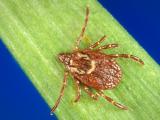Aug 11, 2004 (CIDRAP News) – A medical mystery is baffling infectious disease experts on Martha's Vineyard.
The island off Cape Cod, Mass., has had a string of mysterious tularemia cases. For the fifth summer in a row, people are falling ill with the rare pneumonic form of tularemia, one of the six diseases considered most likely to be spread by terrorists.
The only two reported outbreaks of pneumonic tularemia recorded in the United States have occurred on Martha's Vineyard. Experts from several fields are collaborating to discover why people on the island, particularly landscapers, are contracting the pneumonic form of the illness. The cases may offer lessons for protecting the country from bioterrorism.
Cases don't fit the pattern
Tularemia, also known as "rabbit fever," was first identified as a disease of rodents and other small animals in 1911. It is caused by the bacterium Francisella tularensis. The illness is spread through bites from ticks, deerflies, or other insects; handling infected animal carcasses; eating or drinking contaminated food or water; or inhaling the bacteria. It is not known to spread from person to person. The disease can be fatal if not treated with the right antibiotics, according to the Centers for Disease Control and Prevention (CDC).
Symptoms vary with the type of exposure, but may include sudden fever, chills, headache, diarrhea, muscle aches, joint pain, dry cough, progressive weakness, mouth or skin ulcers, and swollen and painful lymph glands and eyes, according to the CDC. Although the disease can be fatal, the overall case-fatality rate in the United States is less than 2%, according to a JAMA review published in 2001.
Most of the roughly 120 tularemia cases reported in the United States each year are ulceroglandular or glandular cases, usually from tick bites or from handling dead rabbits, said Bela Matyas, MD, MPH, medical director of the epidemiology program for the Massachusetts Department of Public Health. The pneumonic form doesn't often occur under natural circumstances, he told CIDRAP News.
But what is known about tularemia doesn't explain the pneumonic cases on Martha's Vineyard.
One outbreak occurred in 1978. The disease resurfaced in 2000 and has cropped up each summer since. Fifteen cases were identified in 2000; 11 of those patients had the pneumonic form, and one died. Four cases, including three pneumonic, were diagnosed in 2001. At least two pneumonic cases were diagnosed in 2002, followed by four in 2003, according to published reports.
So far this summer, one patient has been confirmed to have pneumonic tularemia and one other has a probable case, Matyas said. A third confirmed case, just reported Aug 10, is not the pneumonic form and is not in a landscaper, he reported. He said the syndrome in the case was not yet clear
Landscapers are consistently more likely than others to contract tularemia than non-landscapers are. In 2001, 9% of 132 landscapers tested seropositive for the F tularensis antibody, compared with less than 1% of other residents in each of three comparison groups, according to a serologic survey conducted by Matyas and colleagues and reported in Emerging Infectious Diseases in March 2003.
People who contracted pneumonic tularemia were more likely to have recently used brush-cutting or mowing equipment, the state health department said in a June press release, adding that exposure likely occurred by inhaling aerosols of contaminated dust, soil, or grass during landscaping activities.
"It's not a casual risk. People are wandering on the same areas the landscapers do without becoming sick," Matyas said. Scientists don't yet know why, but Matyas said his best guess is that F tularensis is in the soil or grass in a form that can become airborne with mechanical disruption.
A survivor's theory
Tristan Israel, who owns a landscaping business, has another theory. He contracted tularemia in June 2001 and spent about 10 days "pretty delirious" with a high fever before antibiotics knocked back the illness. It took even longer to recover physically from the close call, he said in a phone interview.
Although Israel wrote a song about tularemia that refers to lawn mowers chopping up small animals, he believes his illness could be linked to having been "viciously attacked by mosquitoes" a week before his illness.
A selectman on the Tisbury town council for the past 12 years, Israel said people have been fairly calm about tularemia. For example, despite repeated recommendations from health experts, landscapers don't always wear protective masks.
"When it's 85 degrees, it's very difficult to wear a mask. You're outside in the heat and the dust. Wearing a mask doesn't cool you down any," Israel said.
A controversial hypothesis
Sam Telford III, ScD, associate professor of infectious disease at the Tufts University School of Veterinary Medicine in Boston, is listening to theories like Israel's and considering his own. He has interviewed victims, trapped animals, and extensively researched the cases since they began.
Telford told CIDRAP News that he wonders whether the pneumonic tularemia cases are primary or secondary. Studies from the 1940s and 1950s show that, left untreated, any form of tularemia can become pneumonic, he said.
"We don't know what the frequency of pneumonia is even in tularemia that is promptly treated," Telford said. The possibility that the island's tularemia cases aren't contracted through inhalation further complicates the challenge of tracking the disease's reservoir and vector.
Matyas said the state health department, while not rejecting Telford's theory, doesn't feel the evidence supports it. For every case of ulceroglandular tularemia that becomes pneumonic, there should be a large number of primary ulceroglandular cases. Yet doctors have seen very few cases of ulceroglandular tularemia, despite screening for it, Matyas said. In addition, none of the patients with pneumonic disease reported prior symptoms suggesting ulceroglandular disease, he added.
That debate aside, Telford's research shows the disease process on the island is complex. "It's not as simple as landscapers kicking up something from the soil and breathing it in," he said. "Or if it is, what are they breathing in?"
In search of an animal reservoir
Rabbits are often implicated in tularemia, but Telford, who has studied tickborne diseases for 20 years, suspects they may not be the main culprits on Martha's Vineyard. In the past 6 years he has tested more than 250 rabbits on nearby Nantucket Island, which has a high rabbit population. He never saw any evidence of tularemia. There has been only one recent human case of tularemia on Nantucket, in 2001, Telford added.
Martha's Vineyard has a far smaller rabbit population, and several factors have made testing difficult, Telford said. However, three dead rabbits reported on the island tested positive for tularemia, and another dozen tested negative, he reported.
Matyas said rabbits are not the reservoir on Martha's Vineyard. "It's probably some animal that's able to tolerate the bacterium better," he said.
Some as-yet-unidentified insect is helping to maintain the reservoir by spreading among mammals, but that insect doesn't appear to be the route of human infection, Matyas said. "It's very unusual."
To complicate matters, tularemia "hot spots" dot the island, but are difficult to pinpoint. "It's definitely looking for a needle in a haystack," Matyas said.
Telford said Martha's Vineyard has many skunks, raccoons, opossums, and foxes and also has the type of wood tick associated with tularemia. He has found 0.3% to 4.0% of ticks carry F tularensis. The ticks feed on skunks and raccoons. Fifty percent to 80% of skunks and raccoons on the island carry antibodies to tularemia, Telford said. That figure is high compared with at least two reports of studies elsewhere, but few researchers have focused on these animals, he added.
The numbers raise more questions: Are skunks and raccoons an important reservoir that contributes to spreading the pathogen to humans, or just an incidental host that doesn't play a role in transmission?
"The role of raccoons and skunks is not yet determined," Telford said. "The hypothesis that needs to be explored is, perhaps raccoons and skunks are dropping excreta that is mowed over."
He has been sampling raccoons and skunks for 3 years, long enough to be philosophical about getting sprayed by skunks, which becomes fairly routine after the first time, he said. Once, he said, he was sprayed right in the face. That was when he discovered that applying Coca-Cola cuts the stench.
Implications for biodefense
The CDC estimated in 1997 that the total costs to society of an F tularensis aerosol attack would be $5.4 billion for every 100,000 people exposed. A World Health Organization expert committee estimated in 1969 that dispersing 50 kg of aerosolized F tularensis over a metropolitan area with 5 million residents would lead to 19,000 deaths and 250,000 incapacitating casualties.
Because of concerns about bioterrorism, tularemia surveillance has increased nationwide in recent years. It was dropped from the list of nationally notifiable diseases in 1994, but the Council of State and Territorial Epidemiologists reinstated it in 2000 because of its potential use by terrorists, said Lisa Rotz, MD, acting director of the CDC's Bioterrorism Preparedness and Response Program. Now, many states require reporting of cases within 24 hours, and improved diagnostic tests are more readily available to speed confirmation of the illness. Defining tularemia as a potential bioterrorism threat has led to better training to recognize the illness in patients, she added.
Telford said consistent monitoring of wild animal populations could play an important role in biodefense. The Martha's Vineyard cases point up the utility of wildlife surveillance as a tool to give early warning of natural or unnatural outbreaks, he said.
"You need to have wildlife surveillance to complement hospital surveillance," he said. Should an outbreak like the one on Martha's Vineyard occur elsewhere, checking wildlife for previous exposure to tularemia could help determine whether the outbreak is natural or human-caused. If the animals aren't seropositive, it could indicate tularemia is being used as a bioweapon, Telford said.
Yet the mysteries of this outbreak point to a larger concern about biodefense, he added.
"I think the lesson there is, we can't even understand a natural outbreak. A clever, illegitimate outbreak is going to be very hard to investigate," he said. "What we learn out there may give us technologies and ways of answering questions that could help us if we encounter a creative person interested in doing bad. For effective biodefense, we have to think out of the box."
See also:
Feldman KA, Stiles-Enos D, Julian K, et al. Tularemia on Martha's Vineyard: seroprevalence and occupational risk. Emerg Infect Dis 2003;9:3 [Full text]
Dennis DT, Inglesby TV, Henderson DA, et al. Tularemia as a biological weapon: medical and public health management. JAMA 2001;285(21) [Full text]
Kaufman AF, Meltzer MI, Schmid GP. The economic impact of a bioterrorist attack: are prevention and postattack intervention programs justifiable? Emerg Infect Dis 1997;3(2) [Full text]



















